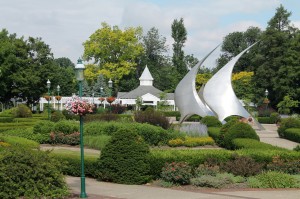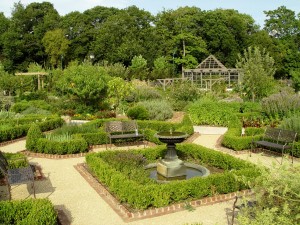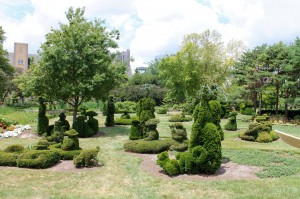Garden-Hopping in Ohio
July 2nd, 2013
Columbus, Ohio, probably doesn’t pop into your mind when you think of great gardens.
But this next-state-capital-west has one of the best clusters of public gardens I’ve seen – underrated and surprisingly unknown to central Pennsylvanians despite being only a 6-hour drive from Harrisburg.
I’m just back from taking a busload of avid (or maybe rabid) local gardeners to see some of Columbus’s little-known gems. We saw eight gardens in three days, including Phipps Conservatory in Pittsburgh on the way back. (See photos here from the trip.)
The people’s favorites turned out to be the community garden at Franklin Park and the Inniswood Metro Gardens, a public park disguised as a botanic garden in the Columbus suburbs.
The Franklin Park community garden isn’t what you might picture. It’s not your traditional rectangle tilled up and marked off into plots where nearby residents plant corn and zucchini.
This one is different from any I’ve seen. It’s more of a 4-acre outdoor gardening classroom, filled with interesting demo plants (hardy kiwi vines, elderberries, Turkish eggplants, etc.), a brick classroom building and all sorts of growing techniques, from raised planter boxes to espaliered fruit trees to screened frames that keep the birds off the strawberries.
The Scotts Miracle-Gro Co. built the Franklin Park community garden in 2009, and it’s operated by the staff at the adjacent Franklin Conservatory – no slough of an attraction either with its 1895 glasshouse similar in function to the U.S. Botanic Garden in Washington.
The community garden is laid out smartly in sectioned rooms by different themes. It’s also weed-free, well trimmed, free to see, and especially useful to anyone trying to grow fruits, veggies, herbs and vines.
Franklin Park Conservatory, by the way, is getting a Bruce Munro light exhibit this September through Christmas. Munro is the British light artist who wowed crowds last summer with his unique installations all throughout Longwood Gardens.
Inniswood Metro Gardens also is unlike anything we’ve got in the Harrisburg area.
This place is a 123-acre county park that originally included the home and gardens of sisters Mary and Grace Innis. The sisters donated 37 acres of the land and their gardens when they died.
Forget what we think of as a county park. Instead of picnic tables, pavilions and maple trees, Inniswood is a network of paved trails through theme gardens – a rose garden with pergolas and stocky wood trellises, a cutting garden, numerous shade and woodland gardens, a rock garden with waterfalls and streams running through it and a new children’s garden with a maze, a wetland and a labyrinth.
What everyone liked best at Inniswood, though, was the cluster of herb gardens.
A knot garden is the centerpiece, and several in our group called it the best they’d ever seen.
I liked the stone-lined, waist-high, circular garden of Mediterranean plants best, with its collection of lavenders and thymes, all backdropped by a wooden blue gazebo.
I asked the ranger on duty how the county managed to fund and maintain this public garden.
It turns out Columbus and the surrounding county have a special tax levy for public parks – similar to how our counties tax to fund libraries.
Ten full-timers maintain Inniswood, plus scores of volunteers who come twice every week.
The place is immaculate and still in growth mode, unlike so many government-run sites that are struggling just to hold on with dwindling staffs and budgets.
The ranger said there’s been no push to scale back staff or budget, and no outcry about frittering away tax money on petunias.
Apparently, Ohioans like plants, parks and planted parks and are OK with funding them.
Woe to any of our county commissioners who might propose a new tax levy to fund gardens in a county park.
At least we can drive to Inniswood to enjoy what those folks have done.
Our bus group also visited:
* Columbus Topiary Park, a landscape of trimmed yews that re-create a famous painting by French artist Georges Seurat. It’s the only place I know of in which trimmed topiaries depict an entire painting. Very unusual.
* Mission Oaks, a series of woodland and perennial gardens in nearby Zanesville, Ohio, with a great collection of conifers built over a one-time tile dump.
* Dawes Arboretum, an 1,800-acre collection of trees and shrubs built by a descendent of Rufus Dawes, a Union general who fought at the battle of Gettysburg. It’s also got several nice perennial gardens, a serene wooded Japanese garden and lake and the name Dawes Arboretum spelled out in trimmed arborvitae hedges over the size of a football field.
* Ohio State University’s Chadwick Arboretum, with its annual-flower trials and excellent display of perennials worthy of home-garden use.
The trip was one of this year’s series my wife, Sue, and I are doing through Lowee’s Group Tours. Five more are on tap this year if you’re interested.











